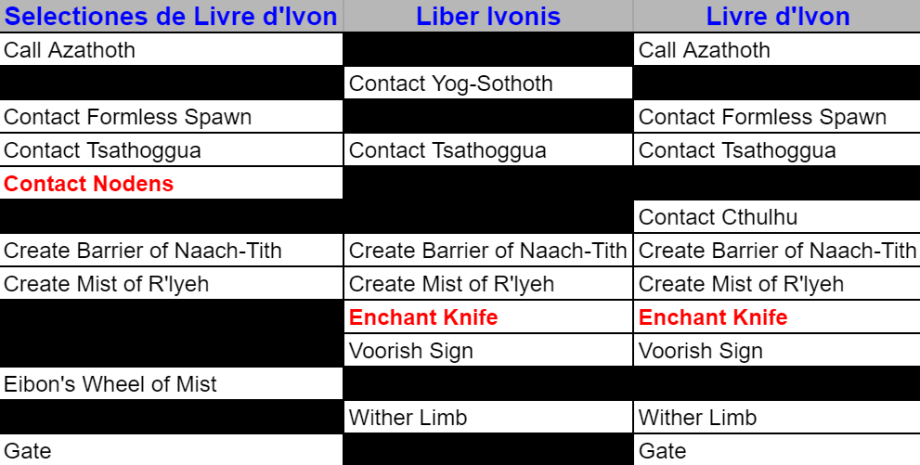If you wish to see some additional background information related to the Book of Eibon, as well as an aggregated presentation of each tome, proceed here.
Location: Roger Carlyle’s Library (America)
Physical Description: Handwritten manuscript bound in decaying blue calfskin

Author: 13th century, Gaspar du Nord’s French commentary on Latin Original. Du Nord was a sorcerer from the Averoigne region (South Central France) that saved himself from the church’s persecution by disrupting his master’s monstrous plans.
Publication History: A handwritten copy by du Nord from an earlier Greek and/or Latin manuscript. The desk in Carlyle’s office reveals the book was purchased as part of a large collection in an auction at a Bavarian estate in April 1918. The book is listed along with 300 additional volumes, none of particular mythos interest.
Skim:
This text introduces itself as a translation of the Book of Eibon by Gaspar du Nord, a 13th-century French magician, using both the Greek and Latin manuscripts of the Book of Eibon as references. This text includes his commentary in footnotes, marginalia, and frequent comparisons to the text he acquired from his master, Nathaire. Mentions his conflict with his former “mentor” and his new, benevolent instructor Z’thoqqua. Will also discover a strange border illustration of an inverted, broken ankh (symbol of the Brotherhood of the Black Pharaoh), which appears to have been added relatively recently. The Sélections may represent du Nord’s working personal copy of the text.
Spells:
Connection to the Broader Campaign:
All three tomes based on the Book Eibon can serve as connections to the Nitocris portion of the campaign.
The Sélections contains a spell to contact Nodens, which offers the only other means of reaching the helpful Mythos entity aside from the Mask of Hayama. Nodens can provide useful clues to disrupt Nyarlathotep and additional advice, particularly regarding the defeat of Nitocris.
The Sélections also contains the image of the Brotherhood’s Inverted Ankh, which may have been sketched by Carlyle from his dreams or hint at prior possession of the tome by a member of the Brotherhood at some point in its past. Perhaps Omar al-Shakti or Gavigan wish to recover the tome to gain access to the powerful Gate spell.
Eibon’s Wheel of Mist offers a powerful protective spell, and you could construct a sidetrack adventure for your Investigators to create the magical disc (depicted below) necessary for this spell.
Thorough Reading:
General Content:
A full study elaborates on the story of Eibon the Great, who lived in a five-story, five-sided tower constructed of black gneiss along the towering cliffs fringing the sea in Mhu Thulan. This dark stronghold originally served as the laboratory and abode of Xylacus; however, he died mysteriously and the alchemical furnaces grew dark as his cadre of pupils dispersed across Hyperborea. Eibon joined this exodus and studied widely across the land, applying secrets he had learned in his master’s vast study. Eibon employed the proscribed mystical gates to travel between lands and worlds, expanding his knowledge while unsettling his consciousness. Eventually, he returned to Mhu Thulan to reclaim the ebon tower and hone his caliginous craft. In a short time, he became regarded as the most powerful sorcerer in all of Hyperborea. His power only deepened in meeting his new master, Tsathoggua, the Sleeper of N’Kai, in the bowels of Voormithadreth, the extinct, four-coned volcano.
“In that secret cave in the depths of Voormithadreth, lies the somnolent black toad, Tsathoggua, coated in a bat-like fur, his darks orbs gazing through drowsing lids as he surveys his formless spawn flowing like ichorous mercury before his corpulent frame. His ancient mind holds glorious secrets, and I freely offered my service. For that, he has gifted me with precious knowledge and dread artifacts.”
Content Specific to Sélections:
Readers will find the origin of this text murky on deeper reading, as the origin of the Latin manuscript may have been a translation of a separate text originating directly from Hyperborea. Alternatively, the translated manuscript may have come to France by way of ancient Egypt. Most of the content contained in Du Nord’s Sélections is similar to the full volume of the Livre d’Ivon translated from Greek; however, there are two specific excerpts identified as noteworthy, which includes discussion concerning enmity between Pazz-luzza and Nodens, which contains Du Nord’s notes on his efforts to reach Nodens (Contact Nodens spell). The passage containing the Inverted Broken Ankh also includes an illustration of a three-legged swastika, which describes the spell Eibon’s Wheel of Mist.

There is a more detailed description of Hyperborea than found in the more technical Livre d’Ivon and Libre Ivonis. Described by du Nord as a legendary continent in the Arctic, which was originally a warm, fertile paradise featuring dense jungles populated by the Earth’s last vestiges of dinosaurs. A race of sentient furred biped, known as the Voormi, once populated Hyperborea, but were eradicated by internecine conflicts and migrating pre-human settlers. The ancestors of the Voormi labored as slaves to the Serpent-people and eventually formed a subterranean, shamanistic culture imitating and worshipping their deity, Tsathoggua. The Voormi established the first capital of Hyperborea, at Commoriom, and later relocated to Uzuldaroum following prophecies of Commoriom’s impending destruction. Eventually, massive ice sheets covered over all of Hyperborea.
Recommended Reading:
- The Book of Eibon, published by Chaosium
- The Colossus of Ylourgne by Clark Ashton Smith
- The Tsathoggua Cycle , published by Chaosium



1 thought on “Mythos Tomes – Sélections de Livre d’Ivon”
Comments are closed.